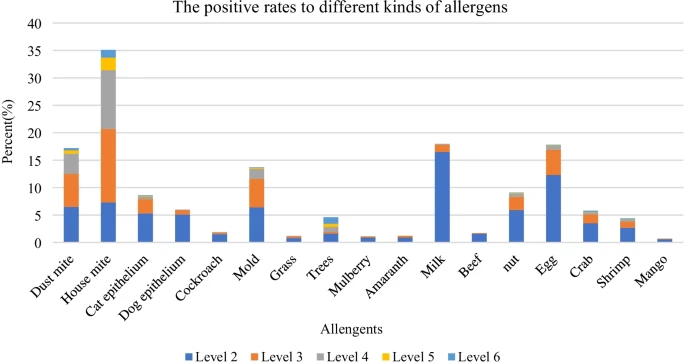- Research
- Open Access
Abstract
Background
The distribution of allergens has geographic characteristics. Local epidemiological data provides evidence-based strategies for the prevention and management of allergic diseases. Age and sex differences may exist in the prevalence of sensitivity to various allergens. We investigated the distribution of common allergens in allergic children in Shanghai, southeastern China.
Methods
39,926 children 1 month to 18 years of age diagnosed with allergic diseases were tested for the presence of serum-specific Immunoglobulins E (sIgE) to 17 allergens common to this region, using a reversed enzyme allergosorbent test.
Results
25,757 (64.5%) of the subjects showed elevated sIgE to at least one of the tested allergens. House mite and dust mite were the most common aeroallergens, while egg and milk were the most common food allergens. The most common aeroallergens and food allergens were similar among each allergic disease. By age-group analysis, the positive rates of aeroallergens were higher at older age. Several peaks of sensitization to food allergens were observed in children between 1 and 3 years of age for eggs, milk, nut, crab and shrimp. In addition, the sensitization to beef and mango was highest in children 3–6 years of age. The rate of positive sIgE detection was higher in males than females for all the tested allergens except cockroach, trees and beef. Considering the interplay between sex and ages and other related components (including season, monthly temperature, humidity, air quality index, test rate of patients), the sIgE positive rates of the main aeroallergens increased with age, while the main food allergens decreased; males are more sensitive to several aeroallergens (including dust mite, house mite, cat epithelium, dog epithelium and mulberry).
Conclusions
House mite, dust mite, milk, and egg are major allergens in Shanghai. Children at younger age are more sensitive to food allergens, while increasing overall prevalence of sensitization can be found with increasing age. Boys have higher positive rates of sIgE responses than girls. Knowledge of the prevalence of allergen sensitization in different age groups and sex may help facilitate diagnosis and intervention efforts to mitigate the impact of allergic diseases in this large geographical region. This approach may be extrapolated to other regions.

No comments:
Post a Comment